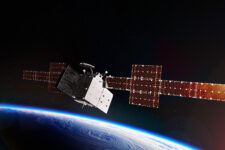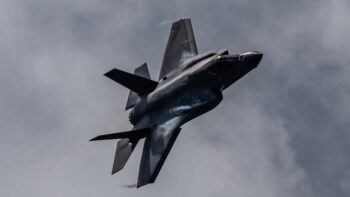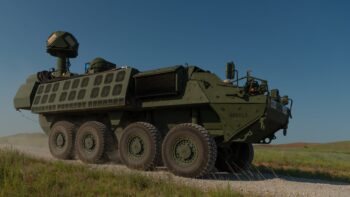
Kelly Hammett, director of the Space Rapid Capabilities Office. (Photo courtesy of the Space Force Assn.)
ORLANDO — Three novel sensor payloads launched by the Space Force in January are now up and running, collecting data on potential on-orbit threats, according to the director of the Space Rapid Capabilities Office (SpRCO).
“They completed testing checkout in like 60 days, which was very, very quick, and they’ve been flying around the GEO [geosynchronous Earth orbit] belt collecting data,” Kelly Hammett told reporters on Wednesday at the Space Force Association’s inaugural Spacepower conference here. “We have learned a lot of interesting data. I can’t go into the details here but I can say that has been shared with the Intelligence Community. It is changing the intelligence estimate on certain foreign capabilities.”
Like most of what SpRCO develops, the exact nature of the “threat warning sensors” is classified, Hammett explained, “so, again, some of the details are shrouded, but we’re continuing to push the frontier.”
The sensor demonstration satellites also are carrying a new, “reprogrammable cryptological payload that gives us enhanced cybersecurity on orbit and reprogram ability of keys and software,” he added.
Hammett said that his office is now working on a plan to transition the payloads “to the rest of the enterprise space for systems to to ensure that these sensors get rolled out and other places besides just our first demo program.”
While the demo sats were developed “specifically to go to GEO,” Hammett said there are “complementary systems” that can be placed in low Earth orbit. “So now the full suite exists. Programs can go out and and find what they need for their orbital regime and for their capability needs and go get it. And like I said, we’re kind of figuring out how to proliferate these across the architecture so that we can get this information, kind of across the board.”
The threat warning sensors are just one of the 17 projects for which tiny SpRCO, comprising 250 people, is now responsible — most of which Hammett said he cannot talk about at all. That said, there are three other projects that are at least in part in the public domain.
Satellite Control Network Update ‘On Track’
The first is the high-priority Satellite Communications Augmentation Resource (SCAR) program designed to field new phased array antennas for the antiquated Satellite Control Network (SCN) by the early 2030s.
The SCN primarily supports launches and early satellite operations, tracks and controls satellites, and provides emergency support to tumbling and lost satellites for constellations owned by the US military, the National Reconnaissance Office, NASA and the National Oceanic and Atmospheric Administration (NOAA).
Unlike the current SCN antennas that can only link to one satellite at a time, SCAR’s phased array models can simultaneously contact between 18 to 20 satellites. SpRCO awarded an Other Transaction Authority agreement with a ceiling of $1.4 billion to BlueHalo in May 2022 for the SCAR effort.
Hammett said the project completed a demo in August, and the first unit remains “on track” for delivery in March 2025.
“I can’t say the particular basing location, but by working with those commands, the basing location for the first unit has been decided. And the modifications to the infrastructure at that location are underway so they’ll be ready for us when we bring the first unit in 15 months,” he added.
R2C2: Managing Dynamic Space Ops
The second effort is known as R2C2, for Rapid Resilient Command and Control (R2C2), and is developing software that will allow Space Force operators to manage hundreds of highly mobile satellites and spacecraft being envisioned for future dynamic space operations.
R2C2 is about “connecting the mission and the capabilities of the satellites with the ability to see to them in a dynamic environment,” Hammett said. “There are a lot of things coming in the next three years, and … now they all need to maneuver to respond to threats. How do you synchronize those? How do you tell everything where to go and when to go there?”
R2C2 will have to “take all the demand signals” from Space Force operators at the new Space Forces-Space operational field command, commanded by Lt. Gen. Doug Schiess, to “go move here, go run away from that thing, go look at that,” he added.
SpRCO already as “a couple of design agents on contract,” and a number of demonstrations in the works that will be “showing working software here in the next three months,” Hammett said. We then will have another contract award — we are in process of awarding another large contract to bring on more design agents. We’ve done all that in in like six months, so we made a ton of progress.”
New, Low-Cost Jammers
Last, but not least, is a project “remote modular terminals,” or RMTs, which are “ground-based jammers,” he said, noting that SpRCO awarded the contract September 2022 “and took delivery of the first four units two months ago.”
According to slides presented during SpRCO’s “industry days” in October by Col. Greg Hoffman [PDF], RMT is a “ground-based electronic warfare system that provides low cost, flexible, satellite communications jamming to help protect joint forces from space-enabled attack.”
Hammett said that he is now having conversations to figure out “who do I have to work with to get them out into the field.”
Commerce extends commercial data contracts for space tracking system pilot
All five contractors — COMSPOC, Kayhan Space, LeoLabs, Slingshot Aerospace, and SpaceNav — received new orders, bringing total “spending over the course of the Consolidated Pathfinder to $15.5 million,” according to an announcement by the Office of Space Commerce.


























